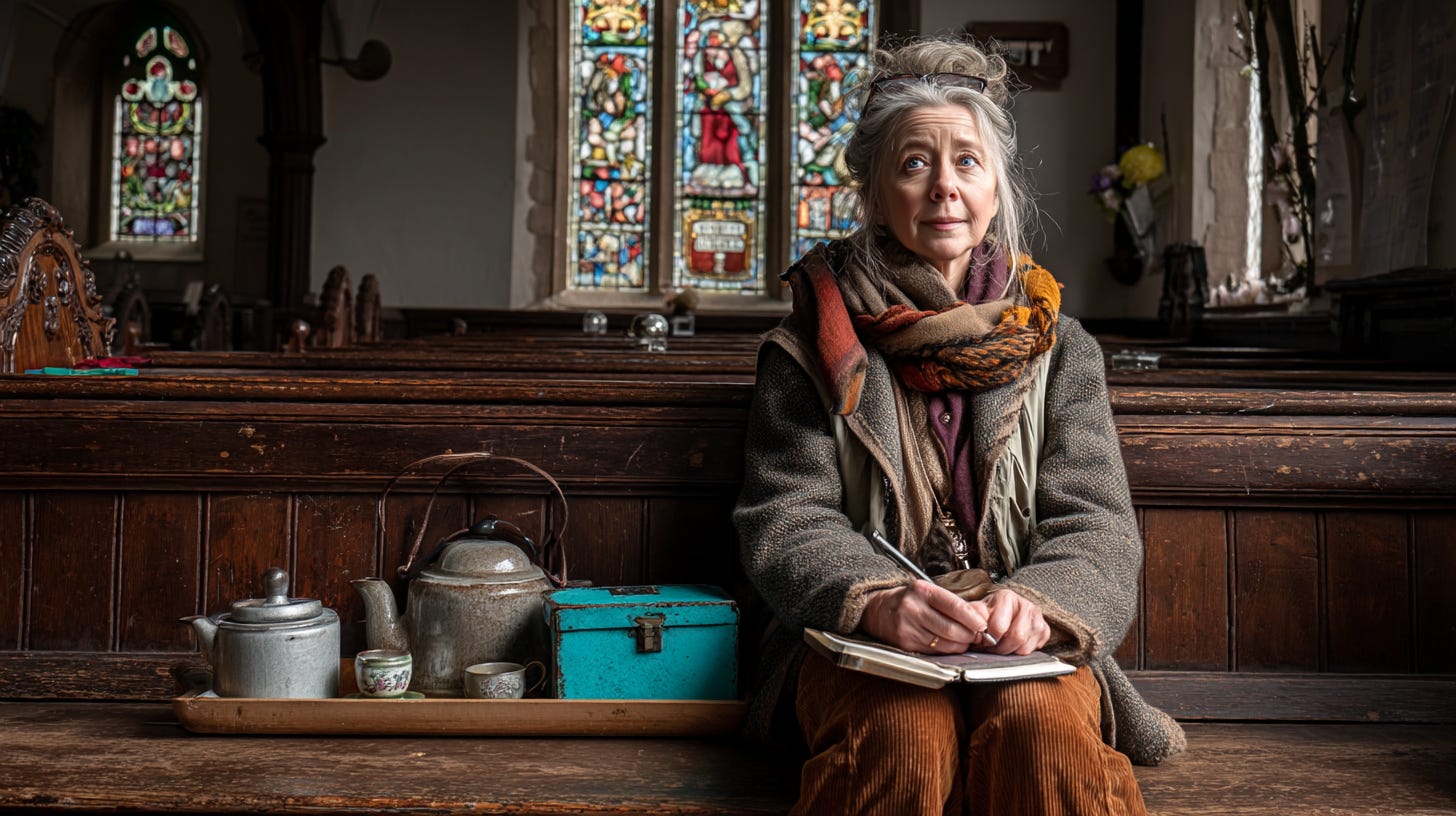It began, as most small village incidents do, with the disappearance of something spectacularly minor: a biscuit tin.
At precisely 10:07 on Tuesday morning, the vicar wheeled in the refreshments trolley—listing slightly, the way it had since the school jumble sale of ’09—for the Ladies’ Stitch-and-Grumble Society. There were two mismatched teapots, a stack of cups, four varieties of herbal infusion no one had asked for, and rock buns so tragically underrisen they appeared to be apologising.
But the tin—the hideous, beloved, royal-blue biscuit tin bearing the long-faded scowl of Queen Victoria—was not among them.
There was a pause, long enough for a cough to be stifled. Then came the murmurs.
One suggested it had collapsed under the weight of communal resentment and custard cream crumbs; another whispered theft. Audrey Crenshaw, who once accused her nephew of art fraud over a suspiciously realistic landscape, declared it was “an inside job.” Enid Finch, wielding a magnifying glass and the tenacity of a crossword champion with something to prove, began questioning the vicar before the second pot had steeped.
The tin, for all its aesthetic crimes, was something of a relic. Rumoured to have been gifted to the parish by a descendant of Queen Victoria’s pastry footman—though no one had ever verified either the lineage or the profession, and Netta had tried—it had served faithfully at village events for decades. It was older than the carpet, older than the extension cord with the melted plug, and according to Audrey, “the only thing left in the hall with real character.”
By morning, the mood had shifted from bemused to watchful. Then someone opened the tea trolley drawer.
The hall was quiet then, a kind of held breath in formica and linoleum. A paper napkin from last year’s Harvest Hamper clung to the edge of the counter like a guest who’d overstayed. Beneath it, Audrey discovered a pencilled message on the back of a crumpled Nativity rota, circa 1994:
To take the tin is to take the burden.
Remember the treaty of ’74.
Within the hour, it had become A Thing.
By mid-afternoon, the church noticeboard had become a battleground.
BISCUITS ARE A BLESSING, NOT A BARGAINING CHIP, read one flyer.
The next day, Maggie noticed something glinting in the sunlight: a laminated treatise—possibly Netta’s—on the perils of communal food storage. The board was eventually cleared by the choir director, who cited spiritual unrest and general confusion.
Maggie kept mostly to herself, as she often did, but she noticed things. Netta Flinn brought her own mint tea in a vacuum flask and unwrapped a solitary fig bar with surgical precision. She did not touch the tray. When Maggie asked her—lightly, casually—if the tin had been moved for cleaning, Netta smiled with terrifying serenity and said only that it was “time to modernise our rituals.”
Maggie said nothing. She merely noted the absence of crumbs.
Mr. Ellery Peale, a transplant from London with a fondness for local ephemera and the scent of tweed, once referred to Audrey as a “heritage fixture.” She has not spoken to him since.
The vicar, looking vaguely unwell, claimed the tin had “simply wandered off,” as if it were a melancholic badger in search of better company. His wife offered individually wrapped ginger thins at the next meeting. They were met with silence and one audible sigh.
The real clue came not from theology or biscuits, but from the bottom shelf of the storage cupboard, where an old ledger marked Biscuit Fund had been gathering dust beside a bottle of altar polish. It contained decades of careful entries—custard creams, £1.10; digestives (plain), 95p; unexpected shortfall, see note—but in the margin, faded ink:
Queen Vic holds the line. Treaty honored.
The Methodist chapel had once shared use of the hall and held strong views on oat-based confections. The tin, it seemed, had been more than storage. It had been a symbol of peace.
Maggie didn’t say it outright, but she may have suggested, in the gentlest possible terms, that someone check the old flats above Wesleyan Court.
Under cover of a loosely scheduled Book Club, the vicar and a reluctant delegate from the flower rota made their visit. Behind a faux organ panel in Flat 3, they found the tin—wedged between hymnals and a suspiciously empty display case, more dented than before but still unmistakably blue.
Netta stood quietly as they opened the panel. She didn’t flinch. When confronted, she confessed without drama. She stood apart as she spoke, arms crossed, cup untouched—like someone who had already grieved the rituals she was dismantling. Her fingers brushed the edge of her sleeve, then stilled. She didn’t look away.
She didn’t need to.
The tin was restored, quietly and without ceremony. A revised treaty was drafted. Audrey insisted on a footnote clarifying the distinction between “wrapped” and “sealed.” Netta declined the biscuits.
At the next meeting, the tin sat slightly off-centre at the end of the trolley. Audrey reached out—just once—and straightened it. No one spoke.
Later, as the last of the tea cooled and the hall emptied, the tin remained.
Still blue.
Still chipped.
Still holding the line.
Maggie lingered just long enough to be alone with it.
She opened her notebook.
She flipped past Jamgate diagrams and fig bar forensic notes, and began a new page.
Case #16: The Queen Vic Incident
Observation: Custard creams may crumble, but treaties endure.
Outcome: Artifact recovered. Ritual renegotiated.
Additional note: Peace is rarely wrapped. Sometimes, it’s simply resealed.
She tapped the page once. Then closed the book.
In the distance, someone laughed a little too brightly.
The tin didn’t move.
But Maggie did.
Just enough to notice.
And then she smiled.
She liked things a little messy.


